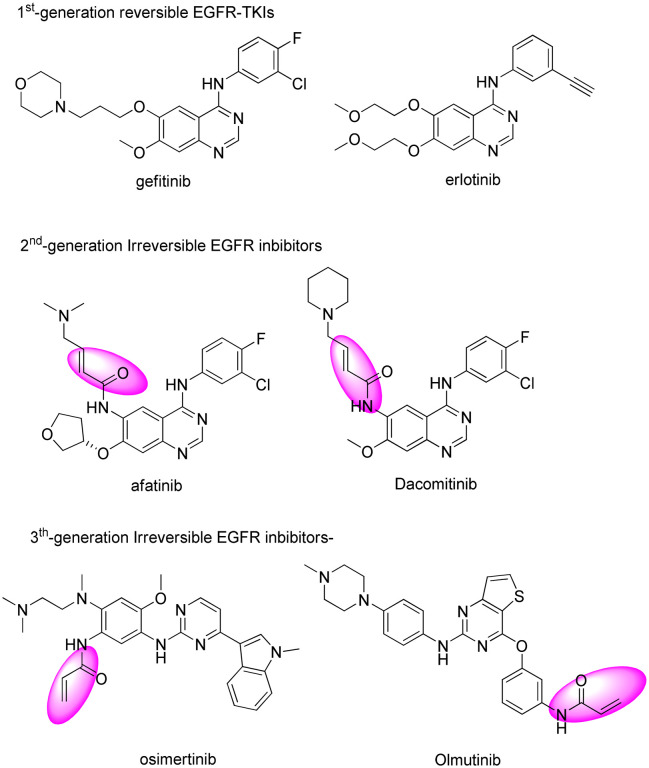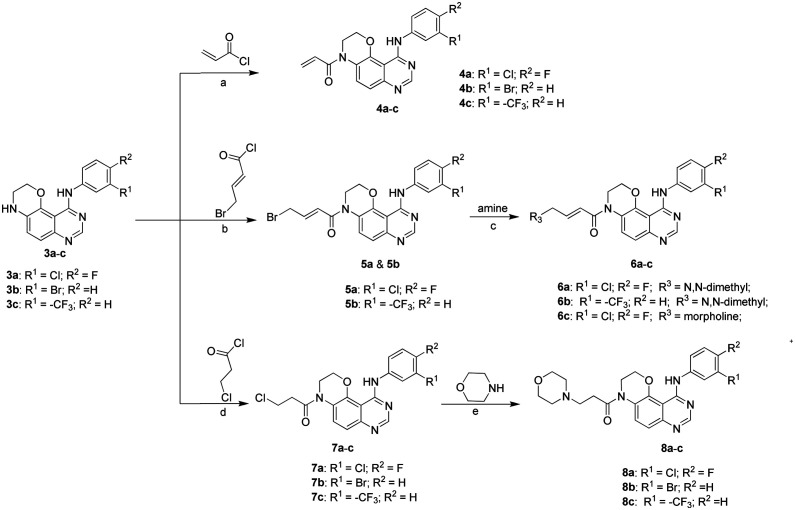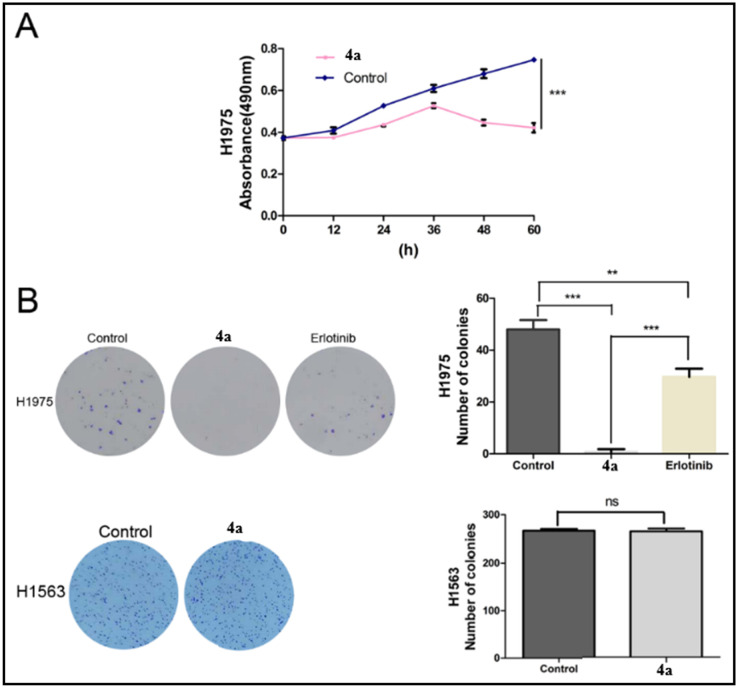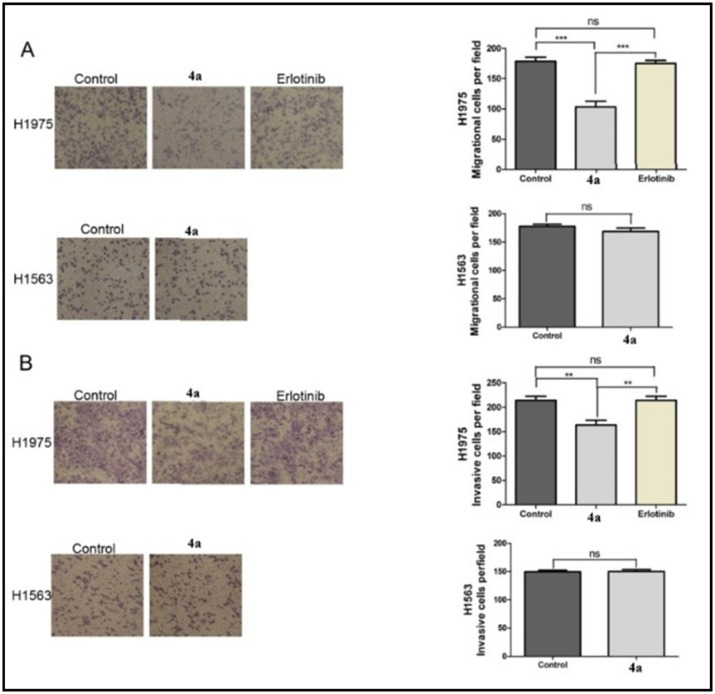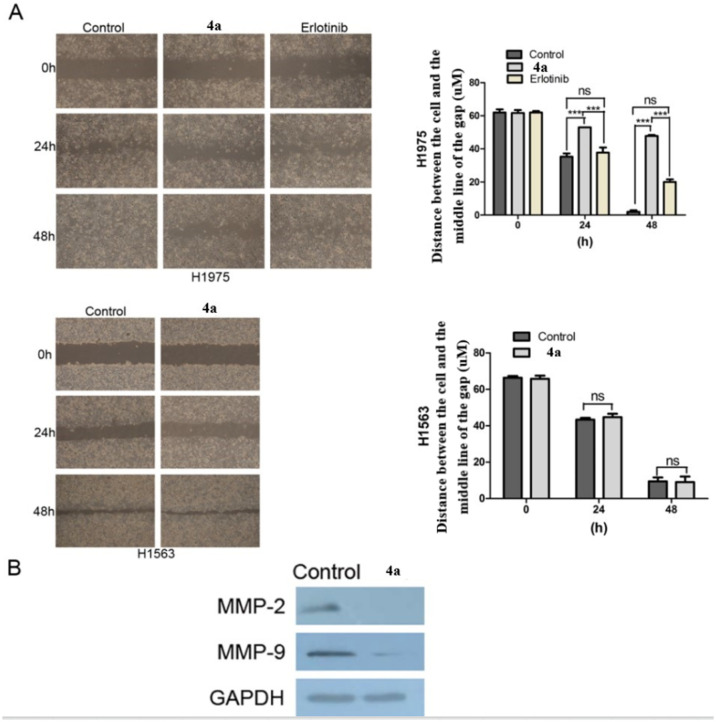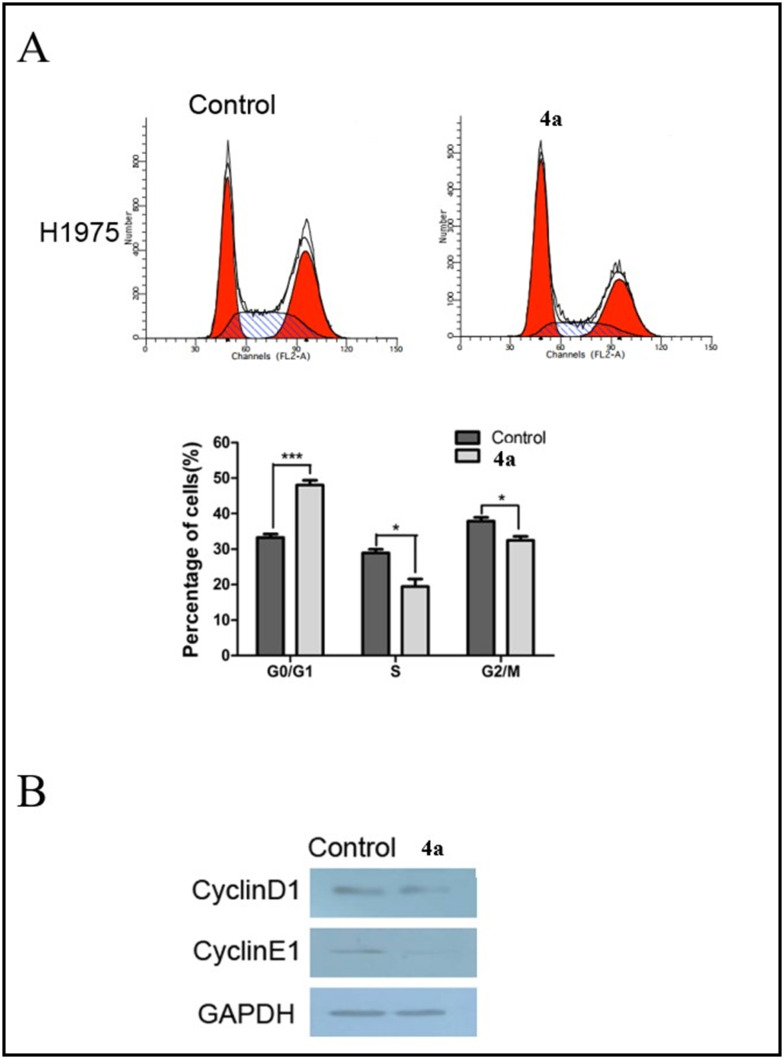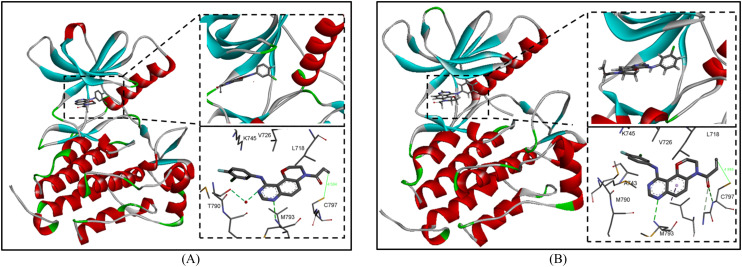Abstract
Epidermal growth factor receptor tyrosine kinase inhibitors (EGFR-TKIs) have emerged as the first-line treatment for patients with EGFR-mutant non-small cell lung cancer (NSCLC). A series of 2H-[1,4]oxazino[2,3-f]quinazolin derivatives were synthesized and evaluated as irreversible EGFR-TKIs for the treatment of NSCLC. Most of the synthesized compounds demonstrated strong inhibitory activity against the EGFR kinase and the tested cancer cells. Notably, compound 4a exhibited considerable inhibitory effects against the EGFR kinase and the EGFRL858R/T790M mutant NCI-H1975 cancer cells. Compound 4a was found to suppress cell proliferation, colony formation, cell invasion, and migration, while also inducing G0/G1 phase arrest of the cell cycle in NCI-H1975 cells. Compound 4a was docked into the active pocket of the EGFR mutant to ascertain the probable binding conformation. Overall, compound 4a was identified as a promising irreversible EGFR-TKI for the treatment of NSCLC.
A series of 2H-[1,4]oxazino[2,3-f]quinazolin derivatives were synthesized. Compound 4a suppressed cell proliferation, colony formation, cell invasion and migration, and induced G0/G1 phase arrest in T790M mutant H1975 cells.
Introduction
Lung cancer has the highest incidence and mortality rates worldwide.1 Non-small cell lung cancer (NSCLC) accounts for approximately 85% of all lung cancer cases.2,3 NSCLC often exhibits activating mutations in the epidermal growth factor receptor (EGFR), including exon 19 deletion mutations and L858R substitution in exon 21.2 The identification of these EGFR mutations has led to the development of targeted therapies for NSCLC.4,5 Chemists have successfully developed three generations of EGFR tyrosine kinase inhibitors (EGFR-TKIs) that have improved overall survival, progression-free survival (PFS), and quality of life for patients.5–7
Compared to standard first-line chemotherapy, gefitinib8 and erlotinib,9 two first-generation and reversible EGFR-TKIs, have been shown to prolong median PFS of patients with metastatic or advanced NSCLC who have EGFR mutations.10–13 However, over 50% of patients treated with these first-generation EGFR TKIs acquired the EGFR T790M mutation within one year of treatment initiation.14–16 Concurrently, activation of downstream signaling pathways through genetic aberrations, including MET gene amplification and HER2 amplification, emerged as other dominant mechanisms driving therapeutic resistance. To address the resistance associated with these mutations, several second-generation EGFR-TKIs, such as afatinib17 and dacomitinib,18 as well as third-generation like osimertinib19 and olmutinib,20 have been developed. These inhibitors feature electrophilic Michael receptor systems that covalently alkylate the conserved cysteine residue (Cys797) at the lip of the ATP binding cleft of EGFR. The common acrylamide structure found in these compounds enables them to irreversibly bind to Cys797 (ref. 6) (Fig. 1).
Fig. 1. Development of three generations of small-molecule EGFR-TKIs (the second-generation and third-generation EGFR inhibitors contained an electrophilic Michael acceptor).
It is important to note that the second-generation EGFR TKIs do not exhibit activity against the acquired mutations, and also the wild-type (WT) EGFR receptor.7 As a result, many patients experience serious side effects, such as rash and diarrhea, shortly after starting the medication. In contrast, third-generation EGFR TKIs irreversibly bind to EGFR through a covalent bond, which plays a crucial role in overcoming resistance to first- and second-generation TKIs and helps prevent the emergence of acquired mutations, such as T790M mutation.21
Osimertinib, a third-generation EGFR inhibitor, has been shown to prolong median PFS and increase the objective response rate (ORR) compared to chemotherapy.22 Today, osimertinib is the most widely used EGFR TKI for NSCLC in the United States.23 Additionally, several fourth-generation EGFR TKIs are either locally approved or in active clinical development,24 such as lazertinib,25 almonertinib26 and rezivertinib.27 However, various genetic alterations have been identified in patients who developed resistance after the administration of third generation EGFR-TKIs as a first-line therapy, including MET gene amplification, C797S mutation, PIK3CA amplification/mutation, HER2 amplification/mutation, and K-RAS and B-RAF mutations.28
In our previous research, we designed a series of quinazoline derivatives by constructing a six-membered ring at the 5- and 6-positions of 4-anilinoquinazoline to serve as reversible EGFR inhibitors.29 We found that compound 7j exhibited excellent activity against the EGFR kinase, with an IC50 of 25.69 nM. This finding led us to believe that addition of a ring involving 5- and 6-positions of the quinazoline would be a rational and innovative approach to design EGFR tyrosine kinase inhibitors. In this paper, we aimed to discover new irreversible EGFR-TKIs by introducing a Michael receptor acrylamide structure to the morpholine-fused quinazoline (Fig. 2). Additionally, we decorated the nitrogen atoms of the A-ring and B-ring based on the known structure–activity relationship (SAR) of quinazoline EGFR inhibitors.
Fig. 2. Design strategy and modification of novel EGFR inhibitors.
Results and discussion
Synthesis
The preparation of target compounds is illustrated in Scheme 1. The synthesis began with compound 3a–c,29 as previously reported in our work. We performed acylation using acyl chloride, which yielded compounds 4a–c, 5a–b, and 7a–c. Next, we combined compounds 5a or 5b with K2CO3 and either dimethylamine or morpholine in DMF to produce compounds 6a–c. Finally, compounds 7a–c were mixed with morpholine in ethanol and heated under reflux to generate compounds 8a–c. The target compounds were characterized by 1H NMR, 13C NMR and HRMS.
Scheme 1. Synthesis of target compounds. Reagents and reaction conditions: (a) THF, 50 °C; (b) DMF/DCM, NEt3, 0 °C; (c) K2CO3, DMF, rt; (d) THF, rt; (e) KI, ethanol, reflux.
Enzyme assay
The Kinase-Glo luminescent kinase assay was selected to evaluate the inhibitory capacity of the new compounds on EGFRwt tyrosine kinase. The results are summarized in Table 1. To assess how the Michael receptor acrylamide structure of the target compounds affects their activity against EGFR kinase, compounds 4a–c and 6a–c were synthesized, and the structure–activity relationships (SARs) of the novel scaffold were investigated.
Table 1. In vitro enzymatic inhibitory activity of target compounds against EGFR.

| ||||
|---|---|---|---|---|
| Compound no. | R1 | R2 | R3 | EGFRwt IC50a (nM) |
| 4a | F | Cl |

|
12.36 |
| 4b | Br | H |

|
13.66 |
| 4c | –CF3 | H |

|
12.09 |
| 6a | F | Cl |

|
13.50 |
| 6b | –CF3 | H |

|
22.39 |
| 6c | F | Cl |

|
10.76 |
| 8a | F | Cl |

|
84.11 |
| 8b | Br | H |

|
166.40 |
| 8c | –CF3 | H |

|
217.20 |
| Gefitinib | 11.75 | |||
Values are averages of two independent determinations.
We synthesized compounds 8a–c, which had no acrylamide structure. All compounds containing the acrylamide structure demonstrated better inhibitory activities against the EGFRwt kinase compared to compound 7j (IC50 = 25.69 nM), which we have previously reported as a reversible EGFR inhibitor.28 Among them, compound 6c displayed the strongest inhibitory activity against EGFRwt kinase (IC50 = 10.76 nM) and was superior to the reference compound gefitinib (IC50 = 11.75 nM). Compounds with a covalent substituent group (4a–c and 6a–c) exhibited significantly better inhibitory activities (IC50 values ranging from 10.76 nM to 22.39 nM) against the EGFR wild-type (EGFRwt) kinase compared to those with a noncovalent substituent group (compounds 8a–c), which had IC50 values from 84.11 nM to 217.20 nM. Moreover, when introducing the 3-chloro-4-fluorophenylamino group (in compounds 4a, 6a, 6c, and 8a), we observed that the compounds featuring the acrylamide structure (compounds 4a, 6a, and 6c) demonstrated an eight-fold improvement in inhibitory activity against EGFRwt compared to compound 8a (IC50 = 84.11 nM), which lacks this structure.
Additionally, when R3 was replaced with a noncovalent substituent group (compounds 8a, 8b, and 8c), the substitution at the 4-position of the quinazoline scaffold with either 3-chloro-4-fluorophenylamino (compound 8a) or 3-bromo-phenylamino (compound 8b) yielded better inhibitory activities against EGFRwt than 3-trifluoromethyl phenylamino (compound 8c). In summary, the inhibitory activity of the target compounds against EGFRwt primarily depends on whether R3 is a covalent substituent group. One possible explanation for this is that the acrylamide structure can covalently and irreversibly bind to the cysteine residue (Cys797), thereby enhancing inhibitory activity.
Cellular anti-proliferative activity
The newly synthesized quinazoline derivatives were assessed for their anti-proliferative activities against human lung cancer cell lines, specifically NCI-H1563 (which expresses high levels of wild-type EGFR kinase) and NCI-H1975 (which harbors the EGFR L858R/T790M mutation). The results are summarized in Table 2.
Table 2. Antiproliferative assay in vitro.
| Compound no. | H1975L858R/T790M IC50a (μM) | H1563wt IC50a (μM) |
|---|---|---|
| 4a | 0.63 ± 0.04 | >40 |
| 4b | 2.00 ± 0.02 | 2.11 ± 0.05 |
| 4c | 1.95 ± 0.08 | 9.29 ± 0.06 |
| 6a | 0.28 ± 0.01 | <1.25 |
| 6b | 0.30 ± 0.07 | <1.25 |
| 6c | 2.24 ± 0.03 | >40 |
| 8a | 2.47 ± 0.03 | >40 |
| 8b | 10.46 ± 0.05 | >40 |
| 8c | >40 | >40 |
| Erlotinib | 4.67 ± 0.04 | 8.17 ± 0.05 |
Data represent the mean values of three independent determinations.
Three of the tested compounds (4b, 6a, and 6b) exhibited better anti-proliferative activities against NCI-H1563 than the positive control, erlotinib. Seven compounds (4a–c, 6a–c, and 8a) demonstrated superior anti-proliferative activities against NCI-H1975 compared to erlotinib. Most compounds containing an acrylamide structure (compounds 4b–c and 6a–c) displayed remarkable inhibitory effects against both NCI-H1563 and NCI-H1975 cells. Interestingly, compound 4a showed weak anti-proliferative activity (IC50 > 40 μM) against NCI-H1563 cells (which express high levels of EGFRwt), but exhibited strong anti-proliferative activity (IC50 = 0.63 μM) against NCI-H1975 cells (which harbor the EGFR L858R/T790M mutation). This suggests that compound 4a demonstrates good selectivity for L858R/T790M mutant EGFR cancer cells.
Cytotoxicity test
Given the promising enzymatic and cellular activities of the target compounds, we further investigated their toxicity against 16HBE cells, which are normal human bronchial cells (Table 3). Compound 4a showed a CC50 value of 2.00 μM, indicating that it is less toxic to normal cell lines compared to erlotinib. This suggests that compound 4a has lower cytotoxicity and a higher safety index. Therefore, we selected compound 4a for subsequent studies.
Table 3. CC50 values of the compounds against 16HBE cells.
| Compound no. | 16HBE CC50a (μM) |
|---|---|
| 4a | 2.00 ± 0.05 |
| 4b | <1.25 |
| 4c | <1.25 |
| 6b | <1.25 |
| 6c | <1.25 |
| 8a | <1.25 |
| Erlotinib | 1.32 ± 0.03 |
Data represent the mean values of three independent determinations.
Compound 4a suppressed EGFR L858R/T790M lung cancer cell proliferation
To evaluate the effect of compound 4a on cell growth and to determine the appropriate drug concentration and duration of treatment, the MTT assay was employed. The optical density (OD) value was measured at 0.75 ± 0.01 after treatment compared to 0.42 ± 0.02 before treatment (P < 0.001, Fig. 3A) in EGFR L858R/T790M-mutated H1975 cells. This significant reduction in the OD value indicates that compound 4a suppressed the viability of H1975 cells harboring the L858R/T790M mutant EGFR.
Fig. 3. (A) The impact of compound 4a on H1975 cell viability was assessed using the MTT assay over a 60-hour period. This experiment was conducted three times, showing statistically significant results (***P < 0.001). (B) Colony formation assays indicate that the number of clones decreases after treatment with compound 4a and erlotinib (0.5 μM) in H1975 cells. However, treatment with compound 4a did not alter clone formation in H1563 cells. The average number of tumor clones is presented in the bar diagram. Results are statistically significant as follows: ***P < 0.001, **P < 0.01, ns (not significant).
Following this, a colony formation assay was performed in both H1975 and H1563 cells. The results showed colony numbers of 48.0 ± 3.2 after treatment compared to 2.1 ± 1.0 before treatment (P < 0.001) in H1975 cells, while in H1563 cells, the numbers were 266.3 ± 4.6 before treatment versus 265.0 ± 6.0 after treatment (P > 0.05). In the case of H1975 cells, the colony numbers were 48.0 ± 3.2 after treatment with compound 4a compared to 29.7 ± 2.9 after treatment with erlotinib (0.5 μM) (P < 0.01). These results suggest that compound 4a exhibits greater inhibitory activity against H1975 cells than erlotinib and only moderately interferes with wild-type H1563 cells.
Cell invasion and migration
The active compound 4a was selected for transwell assays, and the results are presented in Fig. 4. The number of migratory cells was 178.7 ± 6.7 compared to 103.3 ± 9.5 (P < 0.001) for H1975 cells, and 177.7 ± 3.8 versus 168.7 ± 6.1 (P > 0.05) for H1563 cells before and after treatment with compound 4a (0.5 μM). For H1975 cells, the number of migrating cells was 178.7 ± 6.7 compared to 175.0 ± 5.3 (P > 0.05) before and after treatment with erlotinib (0.5 μM) (Fig. 4A). The count of H1975 cells harboring the EGFRL858R/T790M mutation decreased significantly after treatment with compound 4a. These findings suggest that compound 4a effectively suppresses the migration of EGFRT790M lung cancer cells.
Fig. 4. Compound 4a suppresses lung cancer cell invasion and migration (Transwell). (A) Cell migration in H1975 and H1563 cells was assessed before and after treatment with compound 4a (0.5 μM), as well as in H1975 cells before and after treatment with erlotinib. The migratory cell numbers are presented in a bar diagram. Each experiment was repeated three times. ***P < 0.001, ns, ns. (B) Cell invasion in H1975 and H1563 cells was evaluated before and after treatment with compound 4a (0.5 μM), as well as in H1975 cells before and after treatment with erlotinib. The number of cells invading the lower chamber is shown in a bar diagram. Each experiment was repeated three times. **P < 0.01, ns, ns.
Regarding invasive cells, the count was 214.0 ± 7.6 versus 163.7 ± 8.8 (P < 0.01) for H1975 cells and 149.7 ± 2.6 compared to 150.3 ± 2.8 (P > 0.05) for H1563 cells before and after treatment with compound 4a (0.5 μM). For H1975 cells, the invasive cell count was 214.0 ± 7.6 compared to 205.3 ± 4.9 (P > 0.05) before and after treatment with erlotinib (0.5 μM) (Fig. 4B). The number of H1975 cells significantly reduced after treatment with compound 4a. Overall, these results indicate that compound 4a suppresses the migration and invasion of EGFRL858R/T790M lung cancer cells while having a moderate effect on wild-type H1563 cells.
The wound healing assay was utilized to assess cell migration ability. As illustrated in Fig. 5A, the migration capacity of H1975 cells was significantly inhibited when treated with compound 4a (0.5 μM). In contrast, the inhibitory effect of erlotinib on H1975 cells and the effect of compound 4a on H1563 cells were not pronounced. These findings indicate that compound 4a effectively suppresses the migration of EGFR L858R/T790M lung cancer cells while only moderately affecting wild-type H1563 cells. To further investigate the mechanism by which compound 4a influences cell migration and invasion, the expression levels of MMP2 and MMP9 were analyzed using western blot. As shown in Fig. 5B, there was a reduction in the expression levels of MMP2 and MMP9 in H1975 cells after treatment with compound 4a. Overall, these results demonstrate that compound 4a inhibits both the invasion and migration of EGFRL858R/T790M lung cancer cells.
Fig. 5. Wound healing and western blot assay. (A) Wound healing assay results in H1975 and H1563 cells before and after treatment with compound 4a (0.5 μM), as well as in H1975 cells before and after treatment with erlotinib. The migratory cell number is presented by bar diagram. Each experiment was repeated three times. ***P < 0.001, ns, ns. (B) The expression levels of MMP2 and MMP9 were detected by western blot.
Compound 4a induced G0/G1 phase arrest in EGFR L858R/T790M lung cancer cells
To analyze the effect of compound 4a on the cell cycle, flow cytometry was employed. As shown in Fig. 6A, the cell phase distribution indicated that 33.23 ± 1.01% of cells were in the G0/G1 phase before treatment, compared to 48.10 ± 1.28% after treatment (P < 0.001). In contrast, the percentage of cells in the S phase decreased from 28.88 ± 1.03% before treatment to 19.49 ± 2.05% after treatment (P < 0.05). This demonstrates a significant increase in the G0/G1 phase following treatment with compound 4a. These results suggest that compound 4a induces G0/G1 phase arrest in EGFRL858R/T790M lung cancer cells. To further validate this G0/G1 checkpoint arrest, we examined the expression levels of G0/G1 phase-related proteins. Both cyclin D1 and cyclin E1 levels were dramatically reduced before and after treatment with compound 4a (Fig. 6B). Overall, these findings indicate that compound 4a effectively induces G0/G1 phase arrest in EGFRT790M lung cancer cells.
Fig. 6. The effect of compound 4a on H1975 cell cycle. (A) Cell phase distribution in H1975 cells before and after treatment with compound 4a (0.5 μM). The ratio is presented by bar diagram. Each experiment was repeated three times. ***P < 0.001. (B) The expression of cyclinD1 and cyclinE1 was detected by western blot in H1975 cells before and after treatment with compound 4a. GAPDH: internal control.
Binding mode of compound 4a
To further investigate the structure–activity relationship of the target compound, we employed the same experimental methodology to perform molecular docking experiments for the most potent compound 4a with wild-type EGFR (PDB code: 1M17) and T790M EGFR (PDB code: 4G5P), respectively. The experimental results are depicted in Fig. 7A and B. Analysis revealed that compound 4a effectively enters the ATP-binding pocket of the EGFR kinase and forms hydrogen bonds with the hinge residue Met793. Additionally, the distances between the Michael acceptor of compound 4a and Cys797 were 4.584 Å and 4.985 Å, respectively, indicating its potential to form covalent bonds, which partially explains the excellent activity of compound 4a against EGFR kinase.
Fig. 7. (A) Compound 4a binding into the active site of wild-type EGFR kinase (PDB code: 1M17; binding energy: −7.35 kcal mol−1); (B) 2D model of compound 4a binding into the active site of EGFRT790 kinase (PDB code: 4G5P; binding energy: −8.27 kcal mol−1).
However, there were notable differences between the two: the binding energy of the 1M17 protein with compound 4a in Fig. 7A was −7.35 kcal mol−1, while that of the 4G5P protein with compound 4a in Fig. 7B was −8.27 kcal mol−1. This difference explains why compound 4a exhibits strong inhibitory activity against EGFR H1975 cells with L858R/T790M mutation but weaker inhibitory activity against wild-type EGFR H1563 cells. In summary, these findings reveal, at the molecular level, that compound 4a could serve as a potential inhibitor for T790M-mutated EGFR.
Conclusions
In conclusion, we have designed and synthesized a series of 2H-[1,4]oxazino[2,3-f]quinazoline-derivatives that act as EGFR tyrosine kinase inhibitors. Most of the target compounds exhibit strong inhibitory activities against both the EGFR kinase and the tested cancer cells. Notably, compound 4a demonstrated excellent inhibitory activity toward EGFR tyrosine kinase, with an IC50 value of 12.36 nM. It preferentially inhibited the EGFRL858R/T790M mutant H1975 cancer cells (IC50 = 0.63 μM) compared to wild-type EGFR H1563 cells (IC50 > 40 μM), showing lower toxicity to normal cells. This suggests that it has good selectivity for EGFRL858R/T790M mutant cancer cells and minimal side effects. Furthermore, compound 4a suppressed cell proliferation, colony formation, invasion, and migration, while also inducing G0/G1 phase arrest in L858R/T790M mutant H1975 cells. A docking study was conducted to accurately position compound 4a in the EGFR active pocket, suggesting that a covalent bond is likely to form between Cys797 and the Michael acceptor of compound 4a. In summary, we identified the novel molecule 4a as a promising irreversible EGFR L858R/T790M inhibitor with the potential to overcome resistance in non-small cell lung cancer.
Experimental methods
Chemistry
General procedure for synthesis of target compounds (4a–c)
Intermediates 3a–c29 (0.1 mmol) were dissolved in 5 mL of THF, and the solution was cooled to 0 °C. Acryloyl chloride (0.5 mmol), also dissolved in 5 mL of THF, was added dropwise to the reaction mixture. The resulting mixture was then heated at 50 °C for 1 hour. After cooling, the mixture was filtered, and the solid product was recrystallized using isopropanol to obtain the pure product.
1-(10-(3-Chloro-4-fluorophenylamino)-2H-[1,4]oxazino-[2,3-f]quinazolin-4(3H)-yl)prop-2-en-1-one (4a)
White solid; yield: 69%. 1H NMR (500 MHz, DMSO) δ 9.93 (s, 1H), 8.52 (s, 1H), 8.17 (dd, J = 6.8, 2.6 Hz, 1H), 7.81 (ddd, J = 9.0, 4.3, 2.7 Hz, 2H), 7.45 (t, J = 9.1 Hz, 1H), 7.34 (d, J = 9.0 Hz, 1H), 6.91–6.70 (m, 1H), 6.33 (dd, J = 16.8, 2.0 Hz, 1H), 5.89 (dd, J = 10.4, 2.0 Hz, 1H), 4.68 (t, J = 4.6 Hz, 2H), 4.07 (t, J = 4.6 Hz, 2H). 13C NMR (125 MHz, DMSO) δ 157.60, 154.40, 154.14 (d, J = 241.25 Hz), 149.26, 142.78, 136.38, 130.42, 129.68, 129.63, 124.80, 123.83, 123.77, 122.11, 119.45 (d, J = 18.75 Hz), 119.35, 117.00 (d, J = 22.5 Hz), 106.37, 68.74. HRMS (ESI): m/z 385.0863 calcd for C19H14ClFN4O2 [M + H]+, found 385.0863.
1-(10-(3-Bromophenylamino)-2H-[1,4]oxazino-[2,3-f]quinazolin-4(3H)-yl)prop-2-en-1-one (4b)
White solid; yield: 78%. 1H NMR (500 MHz, DMSO) δ 10.91 (s, 1H), 8.82 (s, 1H), 8.18 (s, 1H), 7.93 (t, J = 1.9 Hz, 1H), 7.68–7.65 (m, 1H), 7.56 (dd, J = 8.0, 0.9 Hz, 1H), 7.52–7.45 (m, 2H), 6.35 (dd, J = 16.7, 1.9 Hz, 1H), 5.93 (dd, J = 10.4, 1.9 Hz, 1H), 4.71 (t, J = 4.5 Hz, 2H), 4.10 (t, J = 4.5 Hz, 2H). 13C NMR (125 MHz, DMSO) δ 164.73, 159.84, 151.01, 144.14, 138.83, 133.14, 131.11, 130.22, 129.97, 129.3, 128.50, 125.08, 124.18, 121.67, 114.41, 104.95, 100, 69.07. HRMS (ESI): m/z 411.0452 calcd for C19H15BrN4O2 [M + H]+, found 411.0455.
1-(10-(3-(Trifluoromethyl)phenylamino)-2H-[1,4]oxazino-[2,3-f]quinazolin-4(3H)-yl)prop-2-en-1-one (4c)
White solid; yield: 75%. 1H NMR (500 MHz, DMSO) δ 10.99 (s, 1H), 8.82 (s, 1H), 8.20 (s, 1H), 8.06 (s, 1H), 7.96 (d, J = 7.5 Hz, 1H), 7.79–7.68 (m, 2H), 7.54 (d, J = 9.1 Hz, 1H), 6.82 (dd, J = 16.2, 10.5 Hz, 1H), 6.35 (dd, J = 16.7, 1.8 Hz, 1H), 5.93 (dd, J = 10.4, 1.8 Hz, 1H), 4.76–4.67 (m, 2H), 4.19–4.05 (m, 2H). 13C NMR (125 MHz, DMSO) δ13C NMR (125 MHz, DMSO) δ 164.70 (s), 160.00 (s), 151.06 (s), 147.98 (q, J = 8.7 Hz), 144.14 (s), 138.17 (s), 133.12 (s), 130.41 (s), 130.19 (s), 129.99 (q, J = 32.0 Hz), 129.38 (s), 124.42 (q, J = 270.0 Hz), 124.17 (s), 123.71 (q, J = 32.50 Hz), 123.70 (s), 122.67 (q, J = 3.75), 111.51 (s), 105.03 (s), 69.07 (s). HRMS (ESI): m/z 401.1220 calcd for C20H15F3N4O2 [M + H]+, found 401.1218.
General procedure for synthesis of intermediates (5a and 5c)
Intermediate 3a or 3c (3 mmol) was dissolved in a mixture of CH2Cl2 (15 ml) and DMF (5 ml). The solution was cooled to 0 °C. Acyl chloride (15 mmol) was then added, followed by the dropwise addition of Et3N (20 mmol). The mixture was stirred at temperatures between 0 °C and 10 °C for 2 hours. After the reaction was complete, it was quenched with water and extracted with EtOAc. The organic phase was washed with water, dried over anhydrous Na2SO4, and concentrated under reduced pressure. The resulting residue was purified by silica gel chromatography to yield product 5a or 5c.
General procedure for synthesis of target compounds (6a–c)
Intermediate 5a or 5c (0.4 mmol) was dissolved in 10 mL of DMF. K2CO3 (12 mmol) and an amine (0.6 mmol) were added to the mixture, which was then stirred at room temperature. Once the reaction was complete, it was quenched with water and extracted with ethyl acetate (EtOAc). The organic phase was washed with water, dried over anhydrous Na2SO4, and concentrated under reduced pressure. The residue was purified by silica gel chromatography to yield products 6a–c.
(E)-1-(10-(3-Chloro-4-fluorophenylamino)-2H-[1,4]oxazino-[2,3-f]quinazolin-4(3H)-yl)-4-(dimethylamino)but-2-en-1-one (6a)
White solid; yield: 54%. 1H NMR (500 MHz, DMSO) δ 9.92 (s, 1H), 8.51 (s, 1H), 8.17 (dd, J = 6.8, 2.6 Hz, 1H), 7.87 (dd, J = 6.7, 2.5 Hz, 1H), 7.80 (ddd, J = 9.0, 4.3, 2.7 Hz, 1H), 7.44 (t, J = 9.1 Hz, 1H), 7.32 (d, J = 9.0 Hz, 1H), 6.97–6.72 (m, 1H), 6.58 (d, J = 14.9 Hz, 1H), 4.77–4.57 (m, 2H), 4.14–4.02 (m, 2H), 3.09 (d, J = 4.7 Hz, 2H), 2.18 (s, 6H). 13C NMR (125 MHz, DMSO) δ 164.27, 157.58, 154.35, 154.12 (d, J = 242.5 Hz), 149.19, 144.49, 142.70, 136.40, 130.48, 124.74, 123.76, 123.71, 123.60, 122.31, 119.38 (d, J = 18.75 Hz), 116.99 (d, J = 21.25 Hz), 106.39, 68.75, 60.35, 45.62. HRMS (ESI): m/z 442.1441 calcd for C22H21ClFN5O2 [M + H]+, found 442.1441.
(E)-4-(Dimethylamino)-1-(10-(3-(trifluoromethyl)-phenylamino)-2H-[1,4]oxazino[2,3-f]quinazolin-4(3H)-yl)but-2-en-1-one (6b)
White solid; yield: 48%. 1H NMR (500 MHz, DMSO) δ 10.07 (s, 1H), 8.55 (s, 1H), 8.35 (s, 1H), 8.12 (d, J = 8.5 Hz, 1H), 7.89 (s, 1H), 7.64 (t, J = 8.0 Hz, 1H), 7.49 (d, J = 7.8 Hz, 1H), 7.35 (d, J = 9.0 Hz, 1H), 6.83 (dt, J = 15.2, 5.9 Hz, 1H), 6.60 (d, J = 15.2 Hz, 1H), 4.70 (t, J = 4.6 Hz, 2H), 4.11–4.03 (m, 2H), 3.10 (d, J = 5.4 Hz, 2H), 2.19 (s, 6H). 13C NMR (125 MHz, DMSO) δ 163.76 (s), 157.06 (s), 153.74 (s), 148.69 (s), 143.95 (s), 142.14 (s), 139.43 (s), 130.00 (s), 129.49 (s), 129.29 (q, J = 31.3 Hz), 126.27 (s), 125.19 (s), 123.65 (q, J = 247.5 Hz), 121.85 (s), 120.07 (q, J = 3.75), 118.80, 118.60 (q, J = 3.75), 105.94 (s), 68.24 (s), 59.79 (s), 45.05 (s). HRMS (ESI): m/z 458.1799 calcd for C23H22F3N5O2 [M + H]+, found 458.1805.
(E)-1-(10-(3-Chloro-4-fluorophenylamino)-2H-[1,4]oxazino [2,3-f]quinazolin-4(3H)-yl)-4-morpholinobut-2-en-1-one (6c)
White solid; yield: 58%. 1H NMR (500 MHz, DMSO) δ 9.92 (s, 1H), 8.52 (s, 1H), 8.18 (dd, J = 6.8, 2.5 Hz, 1H), 7.96–7.72 (m, 1H), 7.45 (t, J = 9.1 Hz, 1H), 7.33 (d, J = 9.0 Hz, 1H), 6.82 (dt, J = 15.1, 5.8 Hz, 1H), 6.62 (d, J = 15.0 Hz, 1H), 4.68 (t, J = 4.5 Hz, 2H), 4.10–4.04 (m, 2H), 3.70–3.48 (m, 4H), 3.15 (d, J = 5.4 Hz, 2H), 2.41 (s, 4H). 13C NMR (125 MHz, DMSO) δ 157.57 (s), 154.11 (d, J = 242.5 Hz), 154.35 (s), 153.14 (s), 149.22 (s), 143.73 (s), 142.71 (s), 136.38, 130.52 (s), 124.75 (s), 123.82 (s), 123.74 (d, J = 7.5 Hz), 122.28 (s), 119.37 (d, J = 17.5 Hz), 119.22 (s), 116.99 (d, J = 21.3 Hz), 106.37, 68.77 (s), 66.64 (s), 59.37 (s), 53.79 (s). HRMS (ESI): m/z 484.1547 calcd for C24H23ClFN5O3 [M + H]+, found 484.1550.
General procedure for synthesis of intermediates (7a–c)
Intermediates 7a–c (0.1 mmol) were dissolved in THF (5 ml), and the solution was cooled to 0 °C. A solution of acyl chloride (0.5 mmol) in 5 mL of THF was added dropwise to the reaction mixture. The resulting mixture was then heated at 50 °C for 1 hour. After cooling, the mixture was filtered, and the solid obtained was recrystallized using isopropanol to yield the pure product.
General procedure for synthesis of target compounds (8a–c)
In a solution of 7a–c (2 mmol) in 50 mL of ethanol, 2.6 mmol of morpholine and a catalytic amount of potassium iodide (KI) were successively added. The resulting mixture was heated to reflux for 12 hours. Afterward, the mixture was cooled and evaporated under reduced pressure. The residue was then subjected to silica gel chromatography, yielding compounds 8a–c.
1-(10-(3-Chloro-4-fluorophenylamino)-2H-[1,4]oxazino [2,3-f]quinazolin-4(3H)-yl)-3-morpholinopropan-1-one (8a)
White solid; yield: 50%. 1H NMR (500 MHz, DMSO) δ 9.93 (s, 1H), 8.51 (s, 1H), 8.18 (dd, J = 6.8, 2.6 Hz, 1H), 7.81 (ddd, J = 9.0, 4.3, 2.7 Hz, 1H), 7.45 (t, J = 9.1 Hz, 1H), 7.32 (d, J = 9.1 Hz, 1H), 4.67 (t, J = 4.6 Hz, 2H), 4.00 (m, J = 4.6 Hz, 2H), 3.40 (s, 4H), 2.79 (t, J = 7.2 Hz, 2H), 2.62 (t, J = 6.6 Hz, 2H), 2.35 (s, 4H). 13C NMR (125 MHz, DMSO) δ 171.19 (s), 157.57 (s), 153.29 (s), 154.10 (q, J = 241.3 Hz), 149.10 (s), 142.80 (s), 136.41 (s), 130.76 (s), 124.69 (s), 123.71 (d, J = 6.3 Hz), 122.76 (s), 119.38 (d, J = 18.8 Hz), 119.14 (s), 117.00 (d, J = 21.3 Hz), 106.30 (s), 66.62 (s), 53.76 (s), 40.71–39.89 (m), 39.85 (s), 39.68 (s), 39.51 (s), 31.67 (s). HRMS (ESI): m/z 470.1400 calcd for C23H23ClFN5O3 [M + H]−, found 470.1406.
1-(10-(3-Bromophenylamino)-2H-[1,4]-oxazino-[2,3-f]quinazolin-4(3H)-yl)-3-morpholinopropan-1-one (8b)
White solid; yield: 62%. 1H NMR (500 MHz, DMSO) δ 9.97 (s, 1H), 8.53 (s, 1H), 8.23 (t, J = 1.8 Hz, 1H), 8.12 (s, 1H), 7.90–7.75 (m, 1H), 7.47–7.21 (m, 3H), 4.69 (t, J = 4.4 Hz, 2H), 4.00 (t, J = 4.3 Hz, 2H), 3.55 (s, 4H), 2.82 (t, J = 6.9 Hz, 2H), 2.66 (s, 2H), 2.41 (s, 4H). 13C NMR (125 MHz, DMSO) δ 157.49 (s), 154.28 (s), 140.79 (s), 130.86 (s), 130.75 (s), 126.90 (s), 126.86 (s), 125.02 (s), 124.99 (s), 122.79 (s), 121.78 (s), 119.81 (s), 119.16 (s), 106.40 (s), 99.99 (s), 66.45 (s), 63.76 (s), 53.63 (s), 43.20 (s), 31.50 (s). HRMS (ESI): m/z 498.0969 calcd for 23H23BrN5O3 [M + H]−, found 498.0976.
3-Morpholino-1-(10-(3-(trifluoromethyl)-phenylamino)-2H-[1,4]oxazino[2,3-f]quinazolin-4(3H)-yl)propan-1-one (8c)
White solid; yield: 58%. 1H NMR (500 MHz, DMSO) δ1H NMR (500 MHz, DMSO) δ 10.08 (s, 1H), 9.28 (s, 1H), 8.54 (s, 1H), 8.35 (s, 1H), 8.12 (d, J = 8.6 Hz, 1H), 7.63 (t, J = 8.0 Hz, 1H), 7.49 (d, J = 7.7 Hz, 1H), 7.34 (d, J = 9.1 Hz, 1H), 4.70 (t, J = 4.5 Hz, 2H), 4.02 (t, J = 4.4 Hz, 2H), 3.57 (s, 4H), 2.84 (t, J = 6.8 Hz, 2H), 2.69 (s, 2H), 2.43 (s, 4H). 13C NMR (125 MHz, DMSO) δ 170.98 (s), 157.62 (s), 154.26 (s), 140.00 (s), 130.80 (s), 130.05 (s), 129.75 (d, J = 31.25 Hz), 126.82 (s), 124.68 (q, J = 271.3 Hz), 122.82 (s), 120.62 (q, J = 3.8 Hz), 119.20 (s), 119.16 (q, J = 3.8 Hz), 119.14 (s), 106.42 (s), 99.99 (s), 66.37 (s), 63.76 (s), 53.59 (s), 43.22 (s), 31.45 (s). HRMS (ESI): m/z 486.1758 calcd for C24H24F3N5O3 [M − H]−, found 486.1762.
Data availability
The data supporting this article have been included as part of the ESI.†
Author contributions
Conceptualization: Xuemei Qin and Liming Hu; methodology: Linchang Huang, Ying Zhang; in vitro evaluation: Tingting Cao; data curation: Bo Wang; writing – original draft: Linchang Huang, Peng Liu and Lifang Yang; writing – review & editing: Lihong Lan and Xuemei Qin.
Conflicts of interest
The authors declare no conflicts of interest.
Supplementary Material
Acknowledgments
The authors would like to acknowledge financial support from the Natural Science Foundation of Guangxi Province of China (2024GXNSFBA010176) and the College students' innovation and entrepreneurship training program project of Guangxi Province of China (S202310608152).
Electronic supplementary information (ESI) available. See DOI: https://doi.org/10.1039/d4md01016g
References
- Sung H. Ferlay J. Siegel R. L. Laversanne M. Soerjomataram I. Jemal A. Bray F. Ca-Cancer J. Clin. 2021;71:209. doi: 10.3322/caac.21660. [DOI] [PubMed] [Google Scholar]
- Das D. Xie L. Hong J. RSC Med. Chem. 2024;15:3371. doi: 10.1039/d4md00384e. [DOI] [PMC free article] [PubMed] [Google Scholar]
- Herbst R. S. Morgensztern D. Boshoff C. Nature. 2018;553:446. doi: 10.1038/nature25183. [DOI] [PubMed] [Google Scholar]
- Das D. Xie L. Wang J. Shi J. Hong J. Bioorg. Chem. 2020;99:103790. doi: 10.1016/j.bioorg.2020.103790. [DOI] [PubMed] [Google Scholar]
- Warnecke B. Nagasaka M. Adv. Oncol. 2024;4:63. [Google Scholar]
- Bhatia P. Sharma V. Alam O. Manaithiya A. Alam P. Kahksha K. Alam M. T. Imran M. Eur. J. Med. Chem. 2020;204:112640. doi: 10.1016/j.ejmech.2020.112640. [DOI] [PubMed] [Google Scholar]
- Motta-Guerrero R. Recondo G. Cardona A. Corrales L. Arnao V. Failoc-Rojas V. E. Aliaga C. Crit. Rev. Oncol. Hematol. 2024;196:104294. doi: 10.1016/j.critrevonc.2024.104294. [DOI] [PubMed] [Google Scholar]
- Song X. Wang L. Cai P. Xu Y. Liu Q. Fan D. Toxicol. Appl. Pharmacol. 2024;486:116938. doi: 10.1016/j.taap.2024.116938. [DOI] [PubMed] [Google Scholar]
- Huang S. Zhang J. Wu X. Liang B. Pang N. Yang L. Zhang Z. Life Sci. 2024;351:122849. doi: 10.1016/j.lfs.2024.122849. [DOI] [PubMed] [Google Scholar]
- Costanzo R. Piccirillo M. C. Sandomenico C. Carillio G. Montanino A. Daniele G. Giordano P. Bryce J. De Feo G. Di Maio M. Rocco G. Normanno N. Perrone F. Morabito A. J. Biomed. Biotechnol. 2011;2011:815269. doi: 10.1155/2011/815269. [DOI] [PMC free article] [PubMed] [Google Scholar]
- Liu S. Zhang J. Zeng K. Wu Y. Lung Cancer. 2022;172:160. doi: 10.1016/j.lungcan.2022.05.007. [DOI] [PubMed] [Google Scholar]
- Steins M. Thomas M. Geißler M. Recent Results Cancer Res. 2018;211:1. doi: 10.1007/978-3-319-91442-8_1. [DOI] [PubMed] [Google Scholar]
- Sabbah D. A. Hajjo R. Sweidan K. Curr. Top. Med. Chem. 2020;20:815. doi: 10.2174/1568026620666200303123102. [DOI] [PubMed] [Google Scholar]
- Normanno N. Maiello M. R. Chicchinelli N. Iannaccone A. Esposito C. De Cecio R. D'alessio A. De Luca A. Expert Opin. Ther. Targets. 2017;21:159. doi: 10.1080/14728222.2017.1272582. [DOI] [PubMed] [Google Scholar]
- Lu X. Yu L. Zhang Z. Ren X. Smaill J. B. Ding K. Med. Res. Rev. 2018;38:1550. doi: 10.1002/med.21488. [DOI] [PubMed] [Google Scholar]
- Wu P. Lin M. Hsiao J. Lin P. Pan S. Chen Y. Mol. Cell. Proteomics. 2023;22:100624. doi: 10.1016/j.mcpro.2023.100624. [DOI] [PMC free article] [PubMed] [Google Scholar]
- Jiang Y. Fang X. Xiang Y. Fang T. Liu J. Lu K. Curr. Oncol. 2023;30:5337. doi: 10.3390/curroncol30060405. [DOI] [PMC free article] [PubMed] [Google Scholar]
- Kumar R. Goel H. Solanki R. Rawat L. Tabasum S. Tanwar P. Pal S. Sabarwal A. Med. Drug Discovery. 2024;23:100195. doi: 10.1016/j.medidd.2024.100195. [DOI] [PMC free article] [PubMed] [Google Scholar]
- Schmid S. Li J. Leighl N. B. Lung Cancer. 2020;147:123. doi: 10.1016/j.lungcan.2020.07.014. [DOI] [PubMed] [Google Scholar]
- Kim D. W. Lee D. H. Han J. Lee J. Cho B. C. Kang J. H. Lee K. H. Cho E. K. Kim J. S. Min Y. J. Cho J. Y. An H. J. Kim H. G. Lee K. H. Kim B. S. Jang I. J. Yoon S. Han O. Noh Y. S. Hong K. Y. Park K. Lung Cancer. 2019;135:66. doi: 10.1016/j.lungcan.2019.07.007. [DOI] [PubMed] [Google Scholar]
- Cooper A. J. Sequist L. V. Lin J. J. Nat. Rev. Clin. Oncol. 2022;19:499. doi: 10.1038/s41571-022-00639-9. [DOI] [PMC free article] [PubMed] [Google Scholar]
- Mok T. S. Wu Y. L. Ahn M. J. Garassino M. C. Kim H. R. Ramalingam S. S. Shepherd F. A. He Y. Akamatsu H. Theelen W. S. Lee C. K. Sebastian M. Templeton A. Mann H. Marotti M. Ghiorghiu S. Papadimitrakopoulou V. A. Aura3 Investigators N. Engl. J. Med. 2017;376:629. doi: 10.1056/NEJMoa1612674. [DOI] [PMC free article] [PubMed] [Google Scholar]
- Nagasaka M. Zhu V. W. Lim S. M. Greco M. Wu F. Ignatius Ou S.-H. J. Thorac. Oncol. 2021;16:740. doi: 10.1016/j.jtho.2020.11.028. [DOI] [PubMed] [Google Scholar]
- He J. Zhou Z. Sun X. Yang Z. Zheng P. Xu S. Zhu W. Eur. J. Med. Chem. 2021;210:112995. doi: 10.1016/j.ejmech.2020.112995. [DOI] [PubMed] [Google Scholar]
- Chul Cho B. Han J. Y. Hyeong Lee K. Lee Y. G. Kim D. W. Joo Min Y. Kim S. W. Kyung Cho E. Kim J. H. Lee G. W. Sook Lee S. Lee N. Young Wang J. Park H. Ahn M. J. Lung Cancer. 2024;190:107509. doi: 10.1016/j.lungcan.2024.107509. [DOI] [PubMed] [Google Scholar]
- Zhang M. Quan H. Fu L. Li Y. Fu H. Lou L. Thorac. Cancer. 2021;12:1210. doi: 10.1111/1759-7714.13902. [DOI] [PMC free article] [PubMed] [Google Scholar]
- Yang S. Wu S. Zhao Y. Chen G. Zhu B. Li X. Wang K. Shi J. Cang S. Yao W. Fan Y. Fang J. Zhang L. Zhou J. Wu L. Zheng R. Huang M. Pan Y. Yang Z. Sun M. Yu H. Wang D. Huang J. Wang L. Shu Y. Chen Z. Liu C. Li J. Liu J. Sun S. Guo Y. Meng Z. Liu Z. Han Z. Wu G. Lu H. Ma R. Hu S. Zhao G. Zhang L. Liu Z. Xie C. Zhong D. Zhao H. Bi M. Yi S. Guo S. Yi T. Li W. Lin Y. Chen Z. Zhuang Z. Guo Z. Greco M. Wang T. Zhou A. Shi Y. Lung Cancer. 2023;180:107194. doi: 10.1016/j.lungcan.2023.107194. [DOI] [PubMed] [Google Scholar]
- Wu L. Ke L. Zhang Z. Yu J. Meng X. Front. Oncol. 2020;10:602762. doi: 10.3389/fonc.2020.602762. [DOI] [PMC free article] [PubMed] [Google Scholar]
- Qin X. Liu P. Li Y. Hu L. Liao Y. Cao T. Yang L. Bioorg. Med. Chem. Lett. 2023;80:129104. doi: 10.1016/j.bmcl.2022.129104. [DOI] [PubMed] [Google Scholar]
Associated Data
This section collects any data citations, data availability statements, or supplementary materials included in this article.
Supplementary Materials
Data Availability Statement
The data supporting this article have been included as part of the ESI.†



